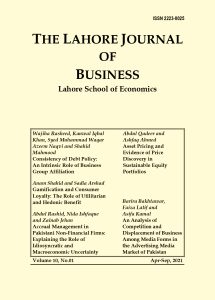Asymmetric Association among Technological Spillover, Absorptive Capacity and Economic Development: A NARDL Approach
- Bushra Mushtaq
- Lecturer, Department of Economics, Lahore College for Women University, Lahore, Pakistan & PhD Scholar, Department of Economics, Government College University, Lahore
Submitted
November 22, 2023
Accepted
November 22, 2023
Accepted
November 22, 2023
Abstract
The spillover of externa research and development (R&D) capital stock and the level of domestic human capital, as a source of absorptive capacity, plays a vital role in stimulating economic growth and development. The objective of this study is to examine the asymmetric associations among human capital, R&D stock spillover, capital import intensity, and output growth in Pakistan over the period 1982 to 2020. For this purpose, we develop and estimate a nonlinearautoregressive
distributed lag (NARDL) model. The results of the bounds test confirm the presence of a long-run relationship, while the error correction model confirms the convergence from short-run to long run equilibrium among the variables. The impact of machinery and technological good imports is positive on per capita GDP in the long run. In contrast, the impact of external R&D capital stock is symmetric in the short but becomes negative in the long run. The relationship between human capital and per capita GDP appears to be asymmetric because of low spending in the education sector. Based on these findings, we suggest that Pakistan should enhance its share of imports of high-tech products and improve its absorptive capacity for the effective use of external R&D resources.
Keywords
Asymmetric association
technology spillover
economic development
This work is licensed under LJB.
- Citation
Mushtaq, B., Afzal, M., & Afzal, M. (2023). Asymmetric Association among
Technological Spillover, Absorptive Capacity and Economic Development: A NARDL
Approach. The Lahore Journal of Business, 11(1), 57-80.
- References
2: Abreo, C., Bustillo, R., & Rodriguez, C. (2021). The role of institutional quality in the international trade of a Latin American country: Evidence from Colombian export performance. Journal of Economic Structures, 10(1), 1–21.
3: Acemoglu, D., & Robinson, J. A. (2006). De facto political power and institutional persistence. American Economic Review, 96(2), 325–330.
4: Adeel-Farooq, R. M., Abu Bakar, N. A., & Raji, J. O. (2017). Trade openness, financial liberalization and economic growth: The case of Pakistan and India. South Asian Journal of Business Studies, 6(3), 229–246.
5: Afzal, M., & Ahmad, H. K. (2018). Technological advancement and total factor productivity growth: A panel data analysis of Asian growing economies. Pakistan Economic and Social Review, 56(2), 231–257.
6: Afzal, M., & Mushtaq, B. (2022). Panel data econometric approach for assessing the determinants of national innovation capacity in Asian growing economies. Pakistan Economic and Social Review, 60(2), 251–275.
7: Afzal, M., Ahmad, H. K. & Mushtaq, B. (2020). National innovation capacity and knowledge creation in advanced economies: An empirical investigation. Innovation: The European Journal of Social Science Research, 1-21.
8: Ahmad, A., Zhao, Y., Shahbaz, M., Bano, S., Zhang, Z., Wang, S., & Liu, Y. (2016). Carbon emissions, energy consumption and economic growth: An aggregate and disaggregate analysis of the Indian economy. Energy Policy, 96, 131–143.
9: Ali, L., & Akhtar, N. (2023). The effectiveness of export, FDI, human capital, and R&D on total factor productivity growth: The case of Pakistan. Journal of the Knowledge Economy, 1-15.
10: Artadi, E. V., & Sala-i-Martin, X. (2003). The economic tragedy of the 20th century: Growth in Africa. National Bureau of Economic Research.
11: Asaleye, A. J., & Strydom, K. (2022). Assessing productivity channels of human capital in the Southern African development community: New insights from women’s empowerment. Journal of Risk and Financial Management, 15(11), 533.
12: Baumol, W., Blackman, S. A., & Wolff, E. (1989). Productivity and American leadership: The long view. MIT Press.
13: Borensztein, E., De Gregorio, J., & Lee, J. W. (1998). How does foreign direct investment affect economic growth? Journal of International Economics, 45(1), 115–135.
14: Caetano, R. V., & Marques, A. C. (2023). Could energy transition be a game changer for the transfer of polluting industries from developed to developing countries? An application of game theory. Structural Change and Economic Dynamics, 65, 351–363.
15: Cantwell, J. (1989). Technological innovations in multinational corporations. The Economic Journal, 100(401), 220–232.
16: Chen, T. T., & Chen, J. (2006). Industry growth factor and FDI intra-industry spillover effect in China. Economic Research Journal, 6, 39–47
17: Chengying, H., Wang, T., Shah, S., Chang, Y., & Zhou, X. (2023). A study on the moderating role of national absorptive capacity between institutional quality and FDI inflow: Evidence from developing countries. Economic Research/Ekonomskaistraživanja, 36(1), 2177–2198.
18: Ciobanu, A. M. (2021). The impact of FDI on economic growth in case of Romania. International Journal of Economics and Finance, 12, 1–81.
19: Coe, D. T., & Helpman, E. (1995). International R&D spillovers. European Economic Review, 9(5), 859–887.
20: Coe, D. T., Helpman, E., & Hoffmaister, A. W. (1997). North-south R & D spillovers. The Economic Journal, 107(440), 134-149.
Read More
